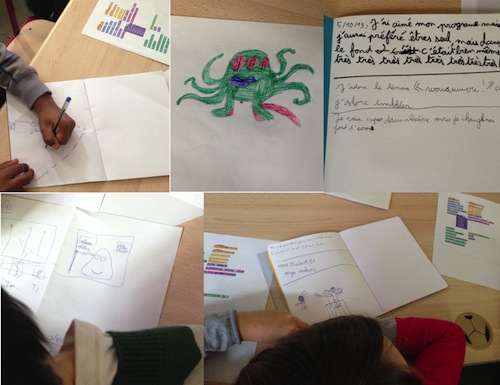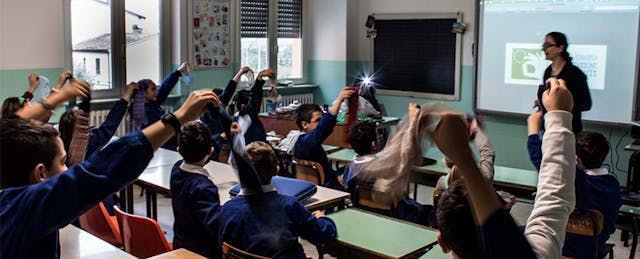The hour is upon us.
The Hour of Code, that is. Tens of thousands of students in the U.S. are taking a crack at looping, sequencing, and assembling lines of code.
But while many educators get students immediately on a computer for the lesson, there are other approaches--like teaching concepts of “computing” without the machine.
Across the Atlantic Ocean, these slightly different approaches to computing are brewing in classrooms and after-school programs. In Italy and France, two teachers in particular support the practice of “creative computing” and integration of Scratch in their classrooms to combat growing unemployment numbers and a European resistance to technology--a certain “technophobia.”
In honor of Computer Science Week, educators Maria Beatrice Rapaccini and Claude Terosier give a peak inside the “creative programming” behind their programming instruction.

Children from the ISC Sigillo School
Fabriano, Italy Maria Beatrice Rapaccini
Over the last few years, a strong interest developed for “educational robotics” in Italy, from preschool up to high school. Many desire to improve awareness of technologies in “digital era natives” (a European phrase, defined as such in the Guidelines for Primary School curriculum). However, the effort is still left to the goodwill of individual schools.
Unemployment is increasing in Italy--especially in my small town of Fabriano (famous for its handmade paper production factory), and teachers should face this crisis by developing creativity and innovation skills in their students.
As a result, together with an association of parents, I embarked upon a creative computing activity last year for two hours a week at Marco Polo Middle School in Fabriano.
The purposes of the course, thanks to the exceptional instrument known as Scratch, are to make the basics of computer programming known, to present the computer as an extremely creative instrument, and to show how it can be connected to the real world using a holistic approach, working at the same time with “hand, head, and heart” (a Pestalozzi concept) in order to let children develop harmonically.

For example, at the beginning of the workshop, the teaching of coding is always introduced by means of unplugged activities. This means that students learn how to code, without the lines of code. Instead, they engage in other activities like acting out CS concepts and digital storytelling (example seen above). And simultaneously, to develop students emotionally and culturally, they use tales by a great Italian writer Gianni Rodari, as well as a Italian/Spanish visual language which is now obsolete: Fotoromanzo.
What’s next? Use Scratch to easily integrate other types of computing software, such Enchanting software for Lego NXT Mindstorms. Or blend subjects like music and robotics, as see below!
Nowadays, as MIT Media Lab Professor Mitch Resnick said in his “Teach Kids to Code” TED talk, it is no longer sufficient for students to simply “read” digital technologies. It is important to be able to “write” them just as well--and that’s what we hope to teach.
Maria Beatrice Rapaccini is an educator from Fabriano, Italy. She teaches “creative computing” at a middle school in Fabriano and a primary school in Sigillo, Perugia. She also teaches math at a professional school in Jesi. Find out more info about her here or Tweet her @tormiento.
Paris, France Claude Terosier
When I started telling people I wanted to teach kids to code, I got some weird looks from many of them. Without over-generalizing, we have a kind of “technophobia” here in France, which seems somehow strange from a country that is so proud of its technological achievements. But programming is not seen as a necessary skill, and some parents even keep their kids away from computer devices altogether.
But not all French citizens are like that.
My first motivation to teach kids how to code was the realization that coding is everywhere, and that in order to navigate through our world, students need to grasp how computers work. I am not a developer, but I feel I understand the impact of technology because I used to code as a telecom engineer student.
As I carried on thinking about the idea of teaching how to code, I understood that coding is a means, not a goal. I took a “Scratch Creative Computing” workshop this summer that was a great enlightenment for me, and while reading Seymour Papert’s paper from his great Mindstorms book, I caught a glimpse of how learning to code was much more about “learning to learn” than anything else.
In our computing workshops, we focus on what the kids want to do. I help them create things, and make sure they learn how to do it. And I’m proud to say that the kids love it!
We’ve embarked together on that discovery journey where we try things and we play together. The instant they started using Scratch, they were fascinated by how code could make characters move around the screen. They made them talk together, added sound and music--there was no stopping them. I give them challenges to spark their imagination (like putting together an "About Me" project or programming a Scratch dance party), and they look around trying to use things I showed them, or tinkering around with commands, and each time they make something personal, something that appeals to them. And with each challenge, they get more acquainted with coding and how to make more complex things.
But it isn’t just about learning to code on a computer.

In our last workshop, we did not touch the computers. The challenge was to invent a story (seen above) and design the characters and settings without using existing images. The kids started working together, imagining, drawing, and building playdough characters. We shot photos of their work, and prepared for the next session, when we’ll start building with Scratch and giving life to the stories through code.
The students are so engaged with what they want to tell in these “digital stories” that learning to code becomes natural, like learning to mix blue and yellow to create some green in your drawing.
What I now tell parents is that their kids will learn to code in order to create. And once they master this tool, there’s no telling how far they’ll go.
Claude is a teacher who started a weekly after-school creative computing workshop in Paris. You can read all about it (in French!) here, in her blog: magicmakers.fr/blog. Her Twitter is @EtClaude.


